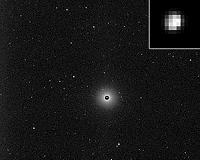 |
Pasadena CA (JPL) May 12, 2011 NASA's Dawn spacecraft has obtained its first image of the giant asteroid Vesta, which will help fine-tune navigation during its approach. Dawn is expected to achieve orbit around Vesta on July 16, when the asteroid is about 188 million kilometers (117 million miles) from Earth. The image from Dawn's framing cameras was taken on May 3 when the spacecraft began its approach and was approximately 1.21 million kilometers (752,000 miles) from Vesta. The asteroid appears as a small, bright pearl against a background of stars. Vesta is also known as a protoplanet, because it is a large body that almost formed into a planet. "After plying the seas of space for more than a billion miles, the Dawn team finally spotted its target," said Carol Raymond, Dawn's deputy principal investigator at NASA's Jet Propulsion Laboratory in Pasadena, Calif. "This first image hints of detailed portraits to come from Dawn's upcoming visit." Vesta is 530 kilometers (330 miles) in diameter and the second most massive object in the asteroid belt. Ground- and space-based telescopes obtained images of the bright orb for about two centuries, but with little surface detail. Mission managers expect Vesta's gravity to capture Dawn in orbit on July 16. To enter orbit, Dawn must match the asteroid's path around the sun, which requires very precise knowledge of the body's location and speed. By analyzing where Vesta appears relative to stars in framing camera images, navigators will pin down its location and enable engineers to refine the spacecraft's trajectory. Dawn will start collecting science data in early August at an altitude of approximately 1,700 miles (2,700 kilometers) above the asteroid's surface. As the spacecraft gets closer, it will snap multi-angle images, allowing scientists to produce topographic maps. Dawn will later orbit at approximately 200 kilometers (120 miles) to perform other measurements and obtain closer shots of parts of the surface. Dawn will remain in orbit around Vesta for one year. After another long cruise phase, Dawn will arrive in 2015 at its second destination, Ceres, an even more massive body in the asteroid belt. Gathering information about these two icons of the asteroid belt will help scientists unlock the secrets of our solar system's early history. The mission will compare and contrast the two giant bodies shaped by different forces. Dawn's science instruments will measure surface composition, topography and texture. Dawn will also measure the tug of gravity from Vesta and Ceres to learn more about their internal structures. The spacecraft's full odyssey will take it on a 5-billion-kilometer (3-billion-mile) journey, which began with its launch in September 2007.
Share This Article With Planet Earth
Related Links Dawn Asteroid and Comet Mission News, Science and Technology
 Dawn - first visual contact with Vesta
Dawn - first visual contact with VestaBonn, Germany (SPX) May 12, 2011 The camera system on board the Dawn spacecraft has acquired its first image of the massive asteroid Vesta. Although the mission's first target is still about 975,000 kilometres away, appearing as just a large white dot, "we now have visual contact with our objective," said Ralf Jaumann of the German Aerospace Center (DLR). In August 2011, the camera will photograph the asteroid from an orb ... read more |
|
| The content herein, unless otherwise known to be public domain, are Copyright 1995-2010 - SpaceDaily. AFP and UPI Wire Stories are copyright Agence France-Presse and United Press International. ESA Portal Reports are copyright European Space Agency. All NASA sourced material is public domain. Additional copyrights may apply in whole or part to other bona fide parties. Advertising does not imply endorsement,agreement or approval of any opinions, statements or information provided by SpaceDaily on any Web page published or hosted by SpaceDaily. Privacy Statement |